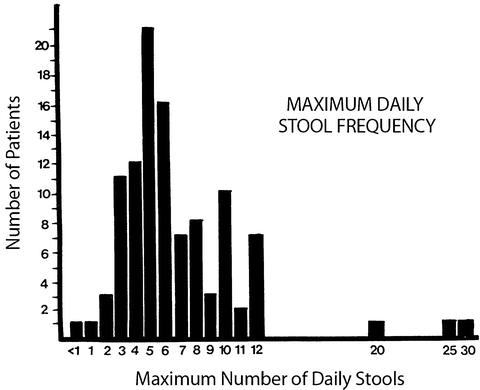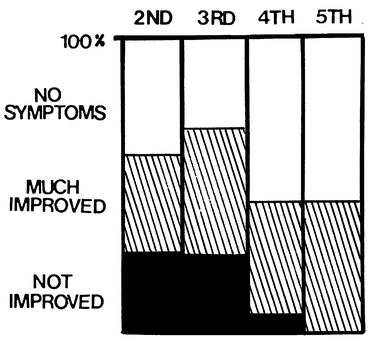(1)
Department of Child Health, University of Missouri, Columbia, MO, USA
Chapter Outline
Description
Management
Chronic, nonspecific diarrhea (CND) presents in infants and preschool children as intermittent or persistent passage of unformed stools that never causes dehydration, weight lag, or disease [2]. Stools typically contain mucus and particles of undigested vegetable matter. There’s the notable absence of blood or the oily globules of undigested dietary triglycerides. It is prevalent in about 15 % of infants and toddlers [3]. These infants are lively and intensely responsive to environmental and emotional stimuli [4].
My retrospective review of 115 consecutive patients referred during a 3-year period revealed that the onset of loose stooling occurred during the first 24 months; 21 % of patients began loose stooling during the first month of life (Fig. 6.1).


Fig. 6.1
The age at onset of CND in 115 consecutive infants referred for evaluation of diarrhea
About half of the patients were noted to have passed pellet stools sometime previously, a feature of irritable bowel syndrome (IBS) in older children and adults. The average maximum number of stools passed per day was 6.8; 32 % reportedly passed 8 or more per day and 15 % patients never passed more than 3 per day (Fig. 6.2).

Sixteen percent were exclusively breast fed, 13 % were fed soy formula, and the remainder consumed cow’s milk, a cow’s milk formula, or an unrestricted diet. By definition, almost all infants and toddlers with CND had normal weight and growth curves. The few whose weight lagged at the time of presentation were found to have been fed a hypo-caloric “diarrhea diet” of some kind. All promptly caught up when allowed an unrestricted diet for age. Family histories revealed symptoms of IBS in 82 % of mothers and 44 % of fathers. In 32 % of patients, both parents had IBS symptoms. (Data from large population surveys have found the prevalence of IBS in only 10–20 % of adolescents and adults [5], which supports the theory that CND is a manifestation of IBS [6].) The diarrheal tendency subsides without treatment by, or long before school age. The diarrhea in 90 % of Murray Davidson’s series of 186 patients [2] subsided before 39 months of age. A follow-up survey of my patients showed a steady decrease in loose stooling over time (Fig. 6.3)

. The physiological basis for loose stooling in CND is functional intestinal hurry rather than inflammation, maldigestion, or malabsorption [7, 8].

Fig. 6.2
Depicts parents’ answers to the question, “At its worst, what was the perceived maximum number of stools passed per day?”

Fig. 6.3
Symptoms reported on follow-up questionnaires from patients previously seen for CND who were now in their 2nd, 3rd, 4th, or 5th years of life. Symptoms improve with time
Management
I favor conservative use of diagnostic studies in normally growing, healthy-appearing infants and toddlers with ongoing loose stooling; these could include inspection of stools for gross blood or oil, examination of a stained smear of stool mucus for pus cells, and stool specimens for pathogenic bacteria and parasites. However, in a thriving infant whose growth curves are normal, time, used in the context of continuity of care and accessibility, is the best management for this non-disease. No disease-caused, chronic loose stooling is likely to have the same benign, self-limited course. Therefore, subjecting a thriving child with this clinical picture to blood tests, endoscopic or radiologic studies is unnecessary.
< div class='tao-gold-member'>
Only gold members can continue reading. Log In or Register to continue
Stay updated, free articles. Join our Telegram channel

Full access? Get Clinical Tree








